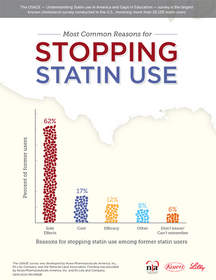John O'Hurley Teams Up With the National Lipid Association, Kowa Pharmaceuticals America and Eli Lilly and Company to Announce Results of Landmark Statin USAGE Survey, Largest Known Survey of Cholesterol Patients
NEW YORK, NY--(Marketwire - June 19, 2012) -
| Highlighted Links |
USAGE survey website |
National spokesperson for the USAGE survey, John O'Hurley, Seinfeld and Dancing with the Stars actor and TV personality, is one of the 71 million Americans diagnosed with high cholesterol.(4) Off of the set, his commitment to public health -- including serving as Public Relations Director of the American Red Cross -- has compelled him to raise awareness of the seriousness of high cholesterol, and the ways patients and doctors can partner to improve conversation around effective cholesterol management.
"I was diagnosed with high cholesterol five years ago, shortly after the birth of our only child. At the time of my diagnosis I had so many questions, and I'm fortunate to have had a thorough and in-depth discussion with my doctor," said John O'Hurley. "Millions of people, like me, are affected by high cholesterol, and it's my hope that the USAGE survey gives them clearer direction on how to bring up concerns with their doctor."
While doctors write more than 200 million prescriptions for statins each year, adherence to treatment remains a significant issue.(2,5) Previous studies indicate that nearly 75% of new statin users stop therapy by the end of the first year.(5) Problems with statin adherence are associated with an increased risk of adverse cardiovascular outcomes -- including heart attack and death(6) -- and contribute to the rising costs of heart disease; expected to reach $818 billion by 2030.(7)
"Heart attack and stroke are the greatest cause of death and disability in the U.S. Despite considerable research showing that statin drugs can help prevent these diseases,(6) many Americans fail to take their statin as prescribed by their doctor. The USAGE survey examines the reasons why patients take or don't take these life-saving drugs correctly," said Dr. Eliot Brinton, spokesman for the National Lipid Association, who also serves as Director of Atherometabolic Research at the Utah Foundation for Biomedical Research. "The USAGE survey results can help doctors and patients work together to make sure statins are prescribed and taken properly. We are excited to help educate healthcare providers and the general public about the USAGE survey to help address this vital health issue."
The USAGE survey explored patient perceptions, attitudes and behaviors about statins, from reasons why patients stopped treatment to education around therapeutic lifestyle changes and drug-drug interactions.
- The USAGE survey shows side effects and cost are the paramount concerns for patients who stop taking their statins:(3)
- 62% of patients surveyed listed side effects as the leading reason why patients stopped taking their statins
- 34% discontinued their statin proactively without consulting their doctor
- 17% of respondents listed cost as the second most common reason for stopping medication
- Only 12% cited lack of efficacy as the motivating factor for stopping medication
- While 81% of patients surveyed report being satisfied with their doctor's explanation of treatment, there is still room for improvement in the doctor-patient dialogue:(3)
- Recollection of cholesterol levels is poor -- respondents were more likely to remember their pant size from high school than their most recent cholesterol level (64% vs. 46%)
- Three out of four female USAGE survey respondents cannot remember their initial LDL-C readings, and more than half cannot recall their most recent LDL-C levels
- The average respondent uses three prescription and/or non-prescription products with drug-drug interaction potential; yet only 38% of all respondents stated they were concerned with potential drug interactions
- 85% of respondents cited their doctor as one of their two most valuable sources for health information; 79% cited their doctors as their most frequent health information source and 39% cited the Internet as their most frequent source
- Former statin users were less likely to be satisfied with their statin and have their total cholesterol levels monitored as frequently as recommended
"As the most valued and frequented source for health information, doctors are key to improving treatment dialogue for patients with high cholesterol," said Dr. Brinton. "The USAGE survey results and resources are available for the public on the USAGE survey website to help patients communicate with their doctors to effectively manage and optimize statin treatment."
Helping to fill the gaps in education about statin use, the USAGE survey website provides downloadable tools and resources, including patient- and medical provider-directed Discussion Guides, a Medication Tracker and presentation for healthcare providers to educate others in the medical community about the USAGE survey and its findings. For more information about the USAGE survey, please visit www.statinUSAGE.com.
The USAGE survey comes at a critical time for heart health; coinciding with the 25th anniversary of the first statin approval in the U.S.(8), the 100th anniversary since the first scientific description of a heart attack(9) and the 10th anniversary of the founding of the National Lipid Association.
About the USAGE Survey
The USAGE survey was fielded from September 21, 2011 to October 17, 2011 via an Internet-based, self-administered questionnaire developed by Kantar Health. All participants self-reported they were over 18 years old and diagnosed with high cholesterol by a doctor. Survey respondents were predominantly Caucasian (92%), female (61%), middle income ($62,912/yr), with health insurance (93%) and with a mean age of 61 years.
About the National Lipid Association
The National Lipid Association (NLA) is a nonprofit, multidisciplinary medical society focused on enhancing the practice of lipid management in clinical medicine. The NLA represents more than 2,500 members in the United States and provides continuing medical education for physicians and other healthcare professionals to advance professional development and promote certification in clinical lipidology.
About Kowa Pharmaceuticals America, Inc.
Kowa Pharmaceuticals America, Inc. (KPA) is a pharmaceutical company specializing primarily in the area of cardiometabolic diseases. The company, started in 2001 as ProEthic Pharmaceuticals, Inc., was acquired by Kowa Company Ltd. in September of 2008. A privately held company, KPA directs its efforts towards the acquisition, licensing and marketing of pharmaceutical products.
About Eli Lilly and Company
Lilly, a leading innovation-driven corporation, is developing a growing portfolio of pharmaceutical products by applying the latest research from its own worldwide laboratories and from collaborations with eminent scientific organizations. Headquartered in Indianapolis, Ind., Lilly provides answers -- through medicines and information -- for some of the world's most urgent medical needs. Additional information about Lilly is available at www.lilly.com.
P-LLY
GEN-0003 MG79013
(1) Data on File: Cholesterol Statin Surveys Audit
(2) Data on File: Wolters Kluwer Pharma Solutions, Source ® Pharmaceutical Audit Suite, Retail Prescription Monthly, January - December 2011.
(3) Data on File: Statin USAGE Survey; Slides 1-76
(4) CDC, "Vital Signs: Prevalence, Treatment, and Control of High Levels of Low-Density Lipoprotein Cholesterol --- United States, 1999--2002 and 2005-2008," Morbidity and Mortality Weekly Report (MMWR), February 4, 2011 / 60(04);109-114.
(5) Tsuyuki, et al., "Poor Adherence with Hypolipidemic Drugs: A Lost Opportunity", Pharmacotherapy 2001;21(5):579.
(6) McGinnis BD, Olson KL, Delate TM, Stolcpart RS: Statin adherence and mortality in patients enrolled in a secondary prevention program. Am J Manag Care. 2009;15:689-95.
(7) Heidenreich, Paul A., et.al. "Forecasting the Future of Cardiovascular Disease in the United States: A Policy Statement From the American Heart Association." Circulation 123 (2011): 933-944. Print.
(8) Tobert, J. "Lovastatin and Beyond: The History of the HMG-COA Reductase Inhibitors." Nature Reviews. 2003. (2): 519.
(9) Muller, JE, "Diagnosis of myocardial infarction: Historical notes from the Soviet Union and the United States," The American Journal of Cardiology 1977; 40(2): 269-271.
Media Contacts
Eliza Merves
Makovsky + Company Inc. for Kowa Pharmaceuticals America, Inc.
Office: (212) 508-9631
Mobile: (908) 256-1243
emerves@makovsky.com
Lisa Garman
Kowa Pharmaceuticals America, Inc.
Office: (334) 288-1288
Mobile: (404) 291-4772
lgarman@kowapharma.com
Tina Gaines
Eli Lilly and Company
Office: (317) 276-3845
Mobile: (317) 366-2568
Gaines_christina_diane@lilly.com
Judi Spann
National Lipid Association
Office: (904) 309-6222
Mobile: (850) 322-9817
jspann@lipid.org




 Digg this
Digg this Bookmark with del.icio.us
Bookmark with del.icio.us Add to Newsvine
Add to Newsvine